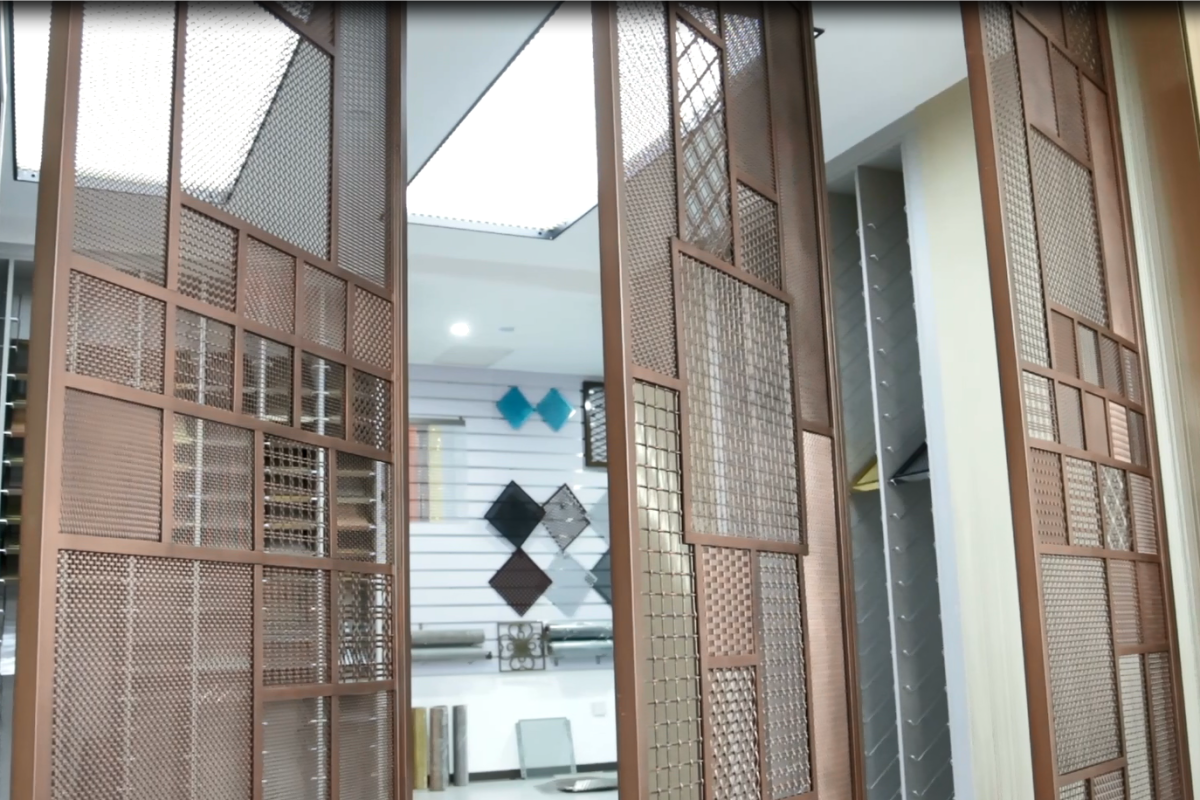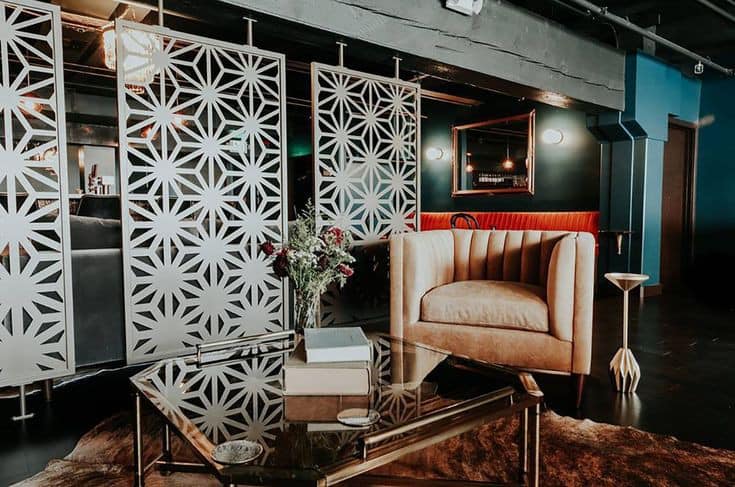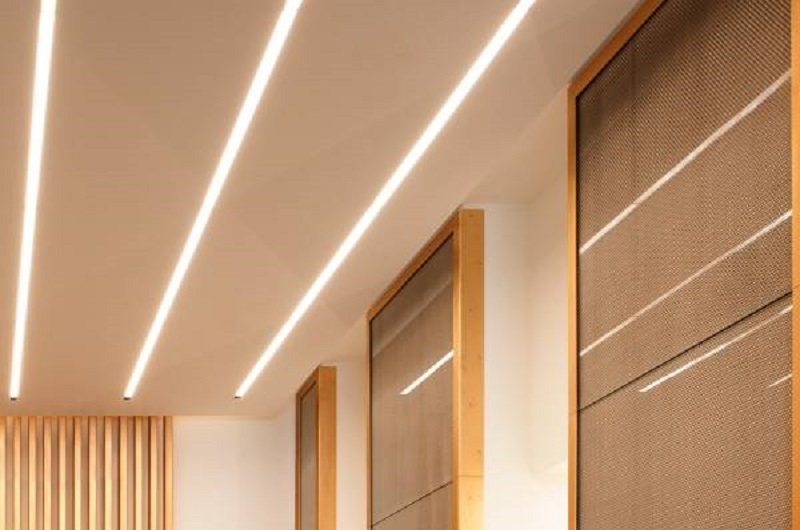1.1 The New Architectural Imperative: From Enclosure to Connectivity
Contemporary commercial architecture is undergoing a fundamental shift, moving away from the traditional model of isolated workspaces and toward a philosophy of openness and collaboration. The rise of flexible work models and a heightened emphasis on employee well-being have rendered the traditional cubicle and solid wall obsolete.
In this context, decorative wire mesh has emerged as a primary example of a new “soft partition” paradigm. These partitions function as visual and subtle physical markers rather than impenetrable walls, helping to delineate traffic flow and establish distinct zones within an open area without fully closing them off from their surroundings. This ability to separate without secluding is a core attribute of modern office design, where a sense of community is valued as highly as individual focus.
1.2 Unveiling the Virtues: Core Advantages of Decorative Wire Mesh
Aesthetics and Design Versatility
Decorative wire mesh is a material designed with aesthetics as a primary consideration, distinguishing it from functional-only meshes used in industrial applications. Its ability to blend artistry with functionality makes it a preferred choice for designers and architects seeking to transform spaces with elegance and sophistication. The woven structure of the mesh creates a highly faceted surface that interacts dynamically with light, absorbing and reflecting the colors of its surroundings. This play of light and shadow adds a dynamic quality to the environment, introducing a sense of texture and depth that is both striking and refined.
A critical feature of decorative wire mesh is its unrivaled level of customization, which empowers designers to tailor the material to precise project specifications. This goes far beyond simple color choices, extending to the fundamental physical and visual characteristics of the product. The material can be made from a variety of raw materials, including stainless steel (Type 304 and 316), brass, copper, bronze, aluminum, and carbon steel. It can then be treated with a wide range of finishes, such as mill finish, copper and brass plating, PVD titanium plating in colors like golden and rose golden, or powder coating in any number of shades. The mesh itself can be fashioned into various architectural patterns and weave types, allowing for a broad spectrum of visual effects, from rigid to malleable. The degree of transparency can be precisely controlled by adjusting the aperture size, which can range from a tightly woven design that adds a light-reflecting texture to a highly open one with over 85% open area, giving designers complete control over visibility and spatial definition.
Optimizing the Built Environment: Light & Airflow
The open design of decorative wire mesh is not merely a visual feature; it provides significant functional benefits by optimizing the built environment. Its primary advantage is the seamless flow of natural light it allows to pass through. By maximizing the infusion of daylight, decorative mesh contributes to healthier and more efficient workspaces, as natural light is proven to enhance mood, energy levels, and overall productivity.
Furthermore, the material’s open structure facilitates superior ventilation, ensuring a comfortable environment for occupants. This is a key advantage over solid partitions, which completely restrict airflow and often require costly, dedicated HVAC solutions to circulate air. The permeability of the mesh also ensures that fire suppression systems are not impeded, allowing sprinklers to function effectively and enhancing safety. By turning light and air into strategic assets that permeate the entire office floor plan, decorative wire mesh fundamentally improves the quality of the built environment.
Durability and Sustainability
Decorative wire mesh is an exceptionally durable material. Made from robust metals like stainless steel, it is built to last and is inherently resistant to corrosion and wear, making it a reliable choice for high-traffic areas. The material’s strength allows it to withstand aggressive physical attacks, ensuring its longevity and structural integrity. This durability translates into low maintenance requirements over its life cycle, as the material is less susceptible to the smudges and scuffs that plague other transparent options or the warping and cracking that can affect wood partitions. From a sustainability standpoint, the use of recyclable materials like stainless steel makes decorative wire mesh a preferred option for environmentally conscious projects.
Table: Core Features and Customization of Decorative Wire Mesh
| Feature | Customizable Parameters |
| Raw Materials | Stainless Steel (304, 316), Aluminum, Brass, Bronze, Copper, Carbon Steel |
| Woven Patterns | Architectural pre-crimped patterns, Plain Square, Double Wire Intercrimp, Helical (Spiral) Crimp, Flat Warp/Round Fill |
| Physical Dimensions | Wire Diameter, Aperture Size (e.g., 6kg/sqm), Opening Area (e.g., 60%, 74%), Weight |
| Finishes | Mill Finish, Copper/Brass Plating, Antique Finishes, PVD Titanium Plating (Golden, Rose Golden, Black, Champagne), Spray Painting, Powder Coating |
2. Comparison between decorative metal mesh and other materials
To objectively evaluate the performance of decorative wire mesh against other common partition materials, it is essential to establish a clear set of criteria. The following analysis will compare each material across six key metrics: Visual Transmittance and Privacy, Airflow and Ventilation, Acoustic Privacy, Flexibility and Modularity, Durability and Longevity, and Relative Cost. This framework provides a transparent and analytical basis for understanding the unique advantages and trade-offs of each material in a modern office context.
Office Partition Material Comparison Matrix
| Criteria | Decorative Wire Mesh | Glass | Drywall | Wood |
| Visual Transmittance & Privacy | Excellent (Customizable) | Excellent (Binary) | None | Partial |
| Airflow / Ventilation | Excellent | None | None | Partial |
| Acoustic Privacy | Limited (with exceptions) | Limited (with specialized glass) | Excellent | Limited |
| Flexibility & Modularity | Excellent | Excellent | None | Limited |
| Durability & Longevity | Excellent | Good | Good | Fair |
| Relative Cost | Moderate to High | High | Low | Moderate to High |
3.1 Foundation of Quality
HIGHTOP Wire Mesh distinguishes itself through advanced manufacturing, precision, and strict quality control. With three dedicated factories, the company ensures consistent production capacity, accurate specifications, and reliable project timelines. By sourcing premium raw materials and holding key certifications, HIGHTOP guarantees both durability and aesthetics, earning the trust of architects and designers.
3.2 Flexibility and Reliability
Beyond manufacturing, HIGHTOP acts as a design partner by offering extensive customization—ranging from patterns and finishes to dimensions. This adaptability supports creative architectural visions, while a strong inventory of standard products prevents delays common in large-scale projects. The balance of bespoke solutions and reliable stock gives HIGHTOP a clear competitive advantage.
3.3 Partnering for Excellence
Decorative wire mesh is no longer a niche choice but a strategic material in modern office and commercial design, combining functionality with aesthetics. HIGHTOP Wire Mesh leads this field by blending superior manufacturing, certified quality, and flexible service. The company delivers more than products—it provides a partnership that enables architects and designers to achieve ambitious, visually compelling, and highly functional spaces.
Please email us via the contact form below, we’ll get back to you as soon as possible.




